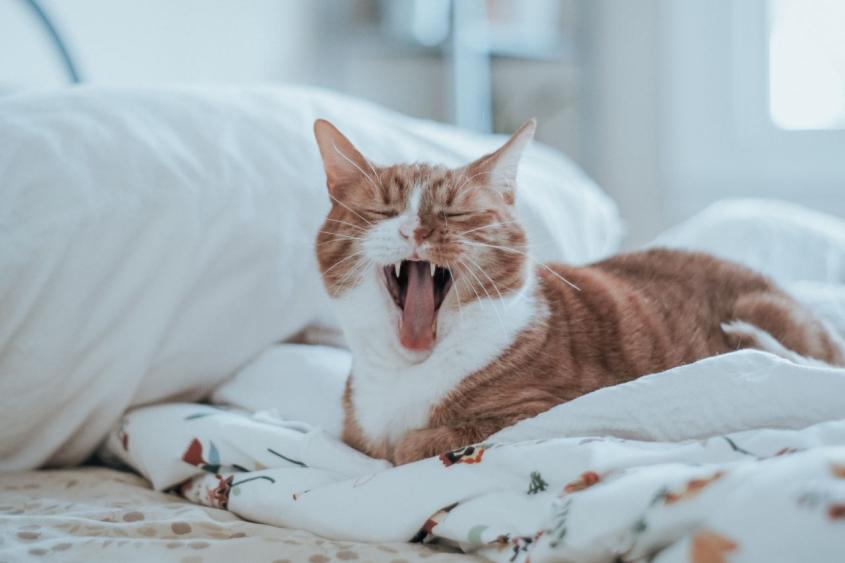Multi-disciplinary team at CVM gains new insights into a chronic feline oral disease
Cats can suffer from a variety of oral diseases, but none more mysterious and debilitating than feline chronic gingivostomatitis (FCGS). This nasty combination of inflammation and ulcers that coat the oral cavity has limited treatments that only address the symptoms and not necessarily the cause of the disease. Currently, FCGS accounts for 0.7%-12% of feline cases seen in veterinary practices.
A multi-disciplinary team of researchers, clinicians, technology experts and scientists at the Cornell University College of Veterinary Medicine (CVM) recently published their work in Scientific Reports, in which they found an increase in a chemical called interleukin-6 (IL-6) in cats with FCGS and offers new therapeutic options. IL-6 is associated with a disturbed immune response, and reducing its levels could resolve many of the clinical issues surrounding the disease.
“This specific disease is very devastating to cats and is poorly understood in the sense that no one really knows what triggers the disease, what individual cats are more at risk, and how to control and ideally cure it," said co-first author Dr. Santiago Peralta, associate professor in dentistry and oral surgery in the Department of Clinical Sciences.
Searching for a culprit
In previous studies, immune cells and certain viruses were found to be associated with the disease, but their direct connections were unclear. In particular, feline calicivirus has been linked to FCGS for about 30 years, and researchers have spent many years trying to understand the role of the virus. This possible connection led to Peralta partnering with Dr. John Parker, associate professor of virology in the Department of Microbiology and Immunology at the Baker Institute for Animal Health. “We initially thought that if the virus is playing a role and is directly responsible for some of the tissue injuries we see in clinically, we should be able to find the virus in the affected tissues," Peralta said.
Surprisingly, the team did not observe active feline calicivirus in any tissue samples from cats with FCGS. However, they did discover genomic material that was not native to cats and originated from viruses, suggesting the viruses are indeed present in affected cats, but may not be playing a direct role in FCGS lesions. Based on preliminary studies, the team hypothesized that feline calicivirus may not be playing a direct role in FCGS, and instead may be triggering the immune responses in these cats.
The goal then became to identify genes associated with FCGS, and particularly those associated with immune response. To do that, the team compared the gene expression patterns in different cats: 20 that were clinically diagnosed with FGCS, six diagnosed with a different oral disease, and eight serving as healthy controls.
Sequencing an answer
Using oral tissue samples stored at the Cornell Biobank, and with the help of the director of the genomics facility and founder of the Transcriptional Regulation & Expression Facility, Dr. Jennifer Grenier, Peralta looked at the immune response in these tissues using RNA-seq, a technique that sequences RNA and measures its quantity in a sample. Comparing the abundance of RNA for different genes in a sample gives a snapshot of which genes are turned on or off, and to what extent.
“-Omic studies produce an ocean of data, and overcoming this initial, inevitable feeling of not really knowing how to start, or where to go next was a huge hurdle for us,” said Peralta. “It took our group three years to find meaning in the data and about three weeks to write it up.”
The team discovered that the IL6 gene, which encodes for the IL-6 protein, was over expressed in cats with FCGS. IL-6 is known to lead to chronic inflammation and increase susceptibility to viral infections when it is highly expressed over a prolonged period. This one molecule can influence most of the inflammation-related mechanisms that have previously been found in cats with FCGS and hints at a larger immune imbalance. “IL-6 driving much of the dysregulated process, clearly and immediately explains the clinical manifestations of the disease. This makes it an obvious candidate for further exploration and validation,” said Peralta. “If these cats truly have an inability to express IL6 at normal levels, we can potentially inhibit IL-6 for an intervention.”
Thanks to this work, scientists are one step closer to creating therapeutics that could target this protein and make this serious feline condition a thing of the past.
By Megan Keller





